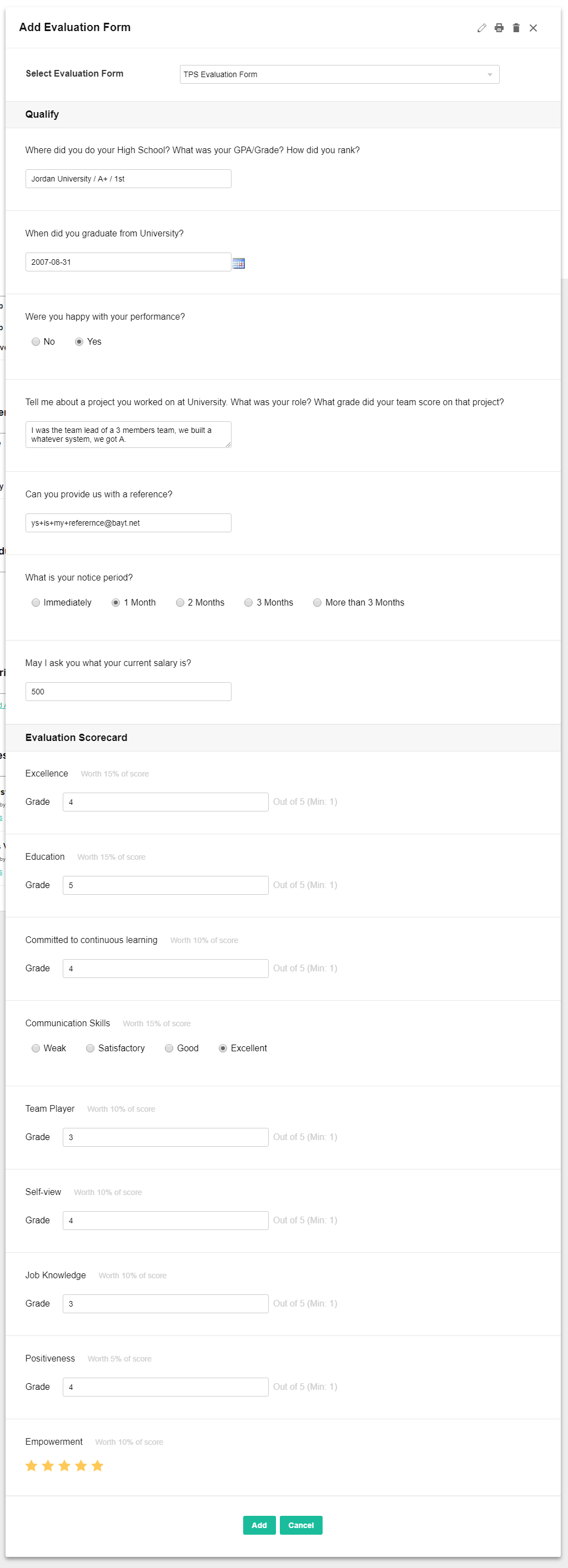
Consider this: You’ve got a box of assorted chocolates with 5 different flavored pieces and you must pick the best one. You’ll try them out and easily reach a favorite, correct? Now make that 25 different flavors and it becomes more likely that you are torn between two or more great chocolates fighting for the top spot. The more options you have, the tougher it gets to pick number one because each contender has something unique going for it.
Evaluating candidates for an opening is quite analogous and you can see how troublesome it can become for recruiters to reach top candidates when the applicant pool grows large. Where the time and effort spent on keeping track of candidate information from disparate sources is certainly a challenge, perhaps a bigger obstacle is comprehensively screening candidates to find the most promising one especially when they are similarly qualified. Solution? Evaluation scorecards.
What are evaluation scorecards?
Scorecards are an intuitive tool that help recruiters and line managers evaluate their candidates against a specific set of criteria/metrics, and compare candidates against the scores of these assessments. With a scorecard, you can structure candidate assessments using one or all of three sections:
- Qualitative section carrying subjective thoughts
- Quantitative section carrying scores
- Final Decision section carrying the next steps
The scorecard can contain questions that assess the candidate’s technical and behavioral skills and can even contain aspects that gauge their culture-fit within the organization.
Here’s what a sample scorecard looks like:

What’s the point of using evaluation scorecards?
Interviews are considered as the go-to tiebreaker when two or more candidates seem fit for a job, but unstructured interviews have some problems of their own. Interviewer notes can be helpful, but this unstructured data is difficult to process. Evaluation scorecards are the most convenient way of implementing a structured evaluation process and many high caliber ATS offer this feature. Here are some of the benefits of using evaluation scorecards to assess your applicants:
1. You get a clear view of the necessary skills
Although recruiters and line managers have an idea about the level of technical proficiency and behavioral skill-set required from an ideal candidate, it becomes difficult to categorize and rank candidates that are the best fit for the job. With evaluation scorecards, evaluators can structure their assessment better and provide standardized feedback that is easy to compare. With a modern ATS, you can create custom scorecards that help you quantify a candidate’s ability in required skills unique to the job role at hand.
2. They make collaboration easier
With a cloud-based ATS, your evaluation scorecards and report cards can be shared across the team with the option of granting different access levels to different members. This is particularly helpful is giving a clear picture of the candidate to a manager who was not present during the interview as compared to verbal or written reports that may have gotten muddled by subjectivity.
3. They keep biases at bay
Even the most professional interviewers are susceptible to biases. It’s common for interviewers to remember candidates by a few memorable things they said which overshadowed their overall performance in the interview. With a properly designed candidate scorecard, you can eliminate these biases by scoring specific questions through a merit-based evaluation. By using a scorecard with weighted questions, you can also ensure that one response does not cast a sweeping impression or an impact larger than it is due. By evaluating every candidate using the same standard criteria, you ensure a level playing field for all candidates where assessments are completely objective.
4. They make the recruitment process data-driven
With most organizations spending about 70% of their operating budgets on workforce expenses, it’s a necessity to measure your ROI on human capital. Although HR metrics like time-to-hire and cost-of-hire are commonly used, measuring hit rate, interview-based predictions and interview question validity are usually ignored which often results in companies either hiring bad candidates or missing out on great ones. With a thorough scorecard system, you have a standard process of gauging a candidate’s true potential and identifying their competitive rather than comparative strengths. This helps in building a database of measurable information that can be used to back data-driven decisions whilst allowing you to improve the content of your application process and interview questions along the way.
5. They inject a lot of efficiency into the hiring process
A scorecard system provides a well-structured process that records valuable information about the candidate and provides measurable insight into his/her sustainability in the organization. They make the applicant evaluation process simpler for recruiters and line managers which makes the overall hiring process remarkably more lean and effective.
6. The documentation helps in auditing
Scorecards allow recruiters to have documented evidence of why a certain person was best for the job which comes in handy later on in performance management and auditing. Moreover, there is clarity on the next steps the recruiter has to take as each scorecard has a decision section which streamlines the entire recruitment process by giving a quantitative lead.
A clear picture
The benefits of a scorecard system are best reaped when you have similarly qualified candidates applying to your organization. They help recruiters rate candidates across skills and requirements of choice which makes it incredibly easy to compare top performers on merits that truly matter for the role and the organization as a whole. When used consistently, scorecards help create a quantitative process for validation which assists your organization in making better hiring decisions over time. What’s more; you can rest assured that a box of assorted chocolates will never be daunting again either.







